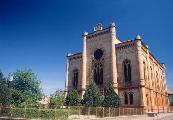Carei - The Synagogue
Document tools
 The first Jewish families arrived in Carei, having been settled by Sándor Károlyi, in the period between 1720 and 1740. They formed a quarter called The Jewish Passage, and the number of Jews increased to 1500 by the middle of the 19th century, and to 3000 by 1940. The construction work of the synagogue was started in 1866, and the Neologist community renovated and modified it in 1890. The Orthodox community built a smaller synagogue nearby, which does not exist today. The present synagogue has three naves, made in the Romantic and Mauro styles. The central nave slightly overcomes in size the side-naves. The main façade, together with the first segment of the secondary façades represent one unit, marked by the columns on the corner, decorated with entablature, resembling the architectural style of the near east. Two central columns from the main façade are taller than the others: they remind us of the temple of Solomon. The cornice is decorated with a register of arcades, and on the top of it two stone-tablets represent The Ten Commandments. The façades of the synagogue have two rows of windows, separated by a simple, median cornice. Above the entrance door is a rose window and a triforium with round windows. The first windows of the secondary façades repeat the shape of the main façade on a smaller scale. Here, at the inferior level is the access door to the synagogue. The secondary façades are divided by pillars. At the choir level, the nave is lightened with triple windows. Above the windows, the frieze is decorated with the recurrent motif of the Star of David, and the upper limit has cornices shaped like arcades. An apse was made at the back of the synagogue, for the niche of the Tora, above which a rose window opens on the upper side. The façade ends with a tympanum. (SzP, TSz).
The first Jewish families arrived in Carei, having been settled by Sándor Károlyi, in the period between 1720 and 1740. They formed a quarter called The Jewish Passage, and the number of Jews increased to 1500 by the middle of the 19th century, and to 3000 by 1940. The construction work of the synagogue was started in 1866, and the Neologist community renovated and modified it in 1890. The Orthodox community built a smaller synagogue nearby, which does not exist today. The present synagogue has three naves, made in the Romantic and Mauro styles. The central nave slightly overcomes in size the side-naves. The main façade, together with the first segment of the secondary façades represent one unit, marked by the columns on the corner, decorated with entablature, resembling the architectural style of the near east. Two central columns from the main façade are taller than the others: they remind us of the temple of Solomon. The cornice is decorated with a register of arcades, and on the top of it two stone-tablets represent The Ten Commandments. The façades of the synagogue have two rows of windows, separated by a simple, median cornice. Above the entrance door is a rose window and a triforium with round windows. The first windows of the secondary façades repeat the shape of the main façade on a smaller scale. Here, at the inferior level is the access door to the synagogue. The secondary façades are divided by pillars. At the choir level, the nave is lightened with triple windows. Above the windows, the frieze is decorated with the recurrent motif of the Star of David, and the upper limit has cornices shaped like arcades. An apse was made at the back of the synagogue, for the niche of the Tora, above which a rose window opens on the upper side. The façade ends with a tympanum. (SzP, TSz). Printable version
Printable version
 Send as email
Send as email
